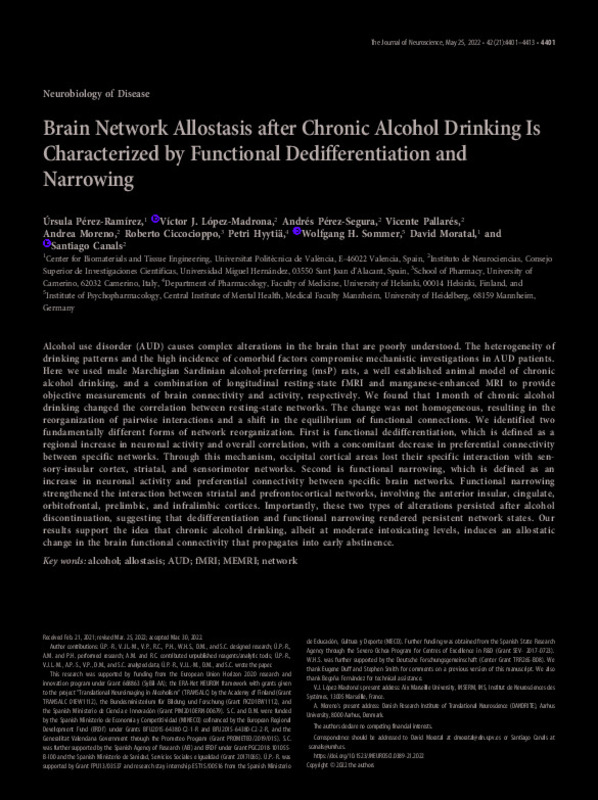|
Resumen:
|
[EN] Alcohol use disorder (AUD) causes complex alterations in the brain that are poorly understood. The heterogeneity of drinking patterns and the high incidence of comorbid factors compromise mechanistic investigations ...[+]
[EN] Alcohol use disorder (AUD) causes complex alterations in the brain that are poorly understood. The heterogeneity of drinking patterns and the high incidence of comorbid factors compromise mechanistic investigations in AUD patients. Here we used male Marchigian Sardinian alcohol-preferring (msP) rats, a well established animal model of chronic alcohol drinking, and a combination of longitudinal resting-state fMRI and manganese-enhanced MRI to provide objective measurements of brain connectivity and activity, respectively. We found that 1 month of chronic alcohol drinking changed the correlation between resting-state networks. The change was not homogeneous, resulting in the reorganization of pairwise interactions and a shift in the equilibrium of functional connections. We identified two fundamentally different forms of network reorganization. First is functional dedifferentiation, which is defined as a regional increase in neuronal activity and overall correlation, with a concomitant decrease in preferential connectivity between specific networks. Through this mechanism, occipital cortical areas lost their specific interaction with sensory-insular cortex, striatal, and sensorimotor networks. Second is functional narrowing, which is defined as an increase in neuronal activity and preferential connectivity between specific brain networks. Functional narrowing strengthened the interaction between striatal and prefrontocortical networks, involving the anterior insular, cingulate, orbitofrontal, prelimbic, and infralimbic cortices. Importantly, these two types of alterations persisted after alcohol discontinuation, suggesting that dedifferentiation and functional narrowing rendered persistent network states. Our results support the idea that chronic alcohol drinking, albeit at moderate intoxicating levels, induces an allostatic change in the brain functional connectivity that propagates into early abstinence.
[-]
|
|
Agradecimientos:
|
This research was supported by funding from the European Union Horizon 2020 research and innovation program under Grant 668863 (SyBil-AA); the ERA-Net NEURON framework with grants given to the project "Translational ...[+]
This research was supported by funding from the European Union Horizon 2020 research and innovation program under Grant 668863 (SyBil-AA); the ERA-Net NEURON framework with grants given to the project "Translational Neuroimaging in Alcoholism" (TRANSALC) by the Academy of Finland (Grant TRANSALC 01EW1112), the Bundesministerium fur Bildung und Forschung (Grant FKZ01EW1112), and the Spanish Ministerio de Ciencia e Innovacion (Grant PIM2010ERN-00679). S.C. and D.M. were funded by the Spanish Ministerio de Economia y Competitividad (MINECO) cofinanced by the European Regional Development Fund (ERDF) under Grants BFU2015-64380-C2-1-R and BFU2015-64380-C2-2-R, and the Generalitat Valenciana Government through the Prometeo Program (Grant PROMETEO/2019/015). S.C. was further supported by the Spanish Agency of Research (AEI) and ERDF under Grant PGC2018-101055B-I00 and the Spanish Ministerio de Sanidad, Servicios Sociales e Igualdad (Grant 2017I065). U. P.-R. was supported by Grant FPU13/03537 and research stay internship EST15/00516 from the Spanish Ministerio de Educacion, Cultura y Deporte (MECD). Further funding was obtained from the Spanish State Research Agency through the Severo Ochoa Program for Centres of Excellence in R&D (Grant SEV-2017-0723). W.H.S. was further supported by the Deutsche Forschungsgemeinschaft (Center Grant TRR265-B08). We thank Eugene Duff and Stephen Smith for comments on a previous version of this manuscript. We also thank Begona Fernandez for technical assistance.
[-]
|









